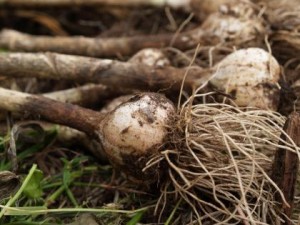
A local farming couple is trying to change the way the state grows garlic by developing special strains resilient in the northern climate.
Lori Jenkins and her husband Wayne live on a farm tucked away in the Fritz Creek area outside of Homer called Synergy Gardens. She loves organic farming. But she really loves garlic.
“When I was little, one of the funnest things was pulling a carrot from the ground and digging a potato and seeing how many and how big. And it’s that same thrill – obviously I get cheap thrills – of digging garlic. It’s just, is it there? Is it perfect? Did something happen to it? Or- there it is, and it’s like little white pearls in the soil,” says Jenkins.
She’s standing in a large shed. On the back wall, rows and rows of garlic are hanging to dry. She pulls some of them down.
“Well, the softnecks- this is a Nootka Rose variety. I’ve already dried them for three weeks and cleaned off the root and cleaned the stems and I’m going to make some braids.”
She deftly weaves them together with rosemary sprigs. She says nowadays, people are used to buying pre-peeled garlic at the store and sometimes are a bit wary of buying a whole head. But the braid makes it extra special.
“To me there’s nothing like a garlic braid. Not only are you bringing something beautiful to their kitchen, but something that tastes delicious. Then, when they go and cook it, it smells so good,” says Jenkins. “I just think it’s so fun when you reach for a braid and twist off a bulb and there’s still some left. It’s almost like you get to harvest again.”
The Nootka Rose that she’s using today is one of three varieties of softneck garlic she’s growing this year along with Silverskin and Red Toch.
Garlic is grown around the world, from Siberia to Guatemala, with different varieties acclimating best to warmer or colder environments. The standard grocery store garlic is a softneck- usually artichoke or silverwhite, much of which is grown in Gilroy, California, known as the Garlic Capital of the U.S. Softnecks do well in warmer places, mature quickly, and stay good for a long time.
“Most Alaskan gardeners advised me not to grow the soft neck. They said it won’t grow good in Alaska,” says Jenkins.
Typically, hardnecks fare better in areas with cold winters, often making them the go-to type for Alaskan growers. Jenkins is growing three of those as well: Georgian Fire, Chesnok Red, and Romanian Red, along with a turban, or hybrid, called Xi’an. But she didn’t want to stick with just those.
“I realized, more research needs to be done. Our weather is shifting, global warming is happening and the change is causing earlier springs and longer falls. And with that, the success of softnecks is possible. I thought, well, instead of importing our seed from the lower 48, for our resilience in Alaska, wouldn’t it be nice if there was a grower who sold varieties that were successful in Alaska?”
That was the start of what she’s named, the Alaska Garlic Project. She wants to develop strains of garlic perfectly suited to both the cold winters and long summers of this state.
We walk outside behind the drying shed where she has several high tunnels filled with tomatoes, veggies, and garlic.
“These first four rows is where I experimented with my silverskins and Nootka Rose softneck garlic. I did outside trials and inside tunnel trials and they sized up equally good but the outside silverskin is still not ready; these ripened a little sooner,” says Jenkins.
But, she says next year, she won’t dedicate her prime tunnel space to garlic; she’ll just wait a little longer. Out in the open air garlic beds, her husband Wayne is digging up heads.
“So I’m using a broadfork which speeds up the harvest of the garlic, getting it broken up out of the soil, so that you can pull the roots without breaking off the stem, so they can be hung up to be dried,” says Jenkins.
He knocks the excess dirt off of one and lays it down in the long row of garlic behind him.
He says, he wishes they could grow several times what they have now, but they are still in the research and development phase of their project.
“It’s all dependent on markets. If we can find out which varieties perform the best for our area of Alaska and then build a website and find out what the size of the market is for fresh garlic cloves, you could refer to it as seed if you wanted to,” says Jenkins. “You know, we’re not just going to go crazy and overplant. It’s all dependent on whether or not we can develop different markets for it.”
Cultivating business is the next step. For now, Lori has already graded out the best of this year’s crop, which came from last year’s which was seed from two years ago. That means, come next summer, she’ll have third year Alaskan-cultivated garlic.
“It’s like apples, you know, we grew up on Red Delicious and Granny Greens. And all of a sudden now, we’re in love with Galas and Pink Ladies and the different varieties of apples are more popular than your old-time favorites. So, just because we knew garlic was good from Gilroy, I think we’re ready to try new varieties for flavor, taste, and sensations,” says Jenkins.
And she wants to show it can be done right here on home soil.




